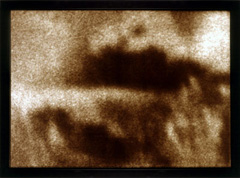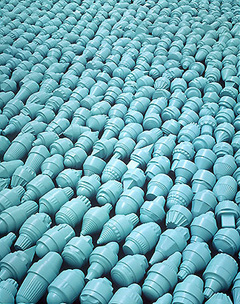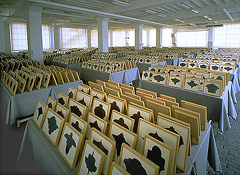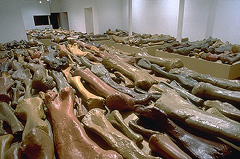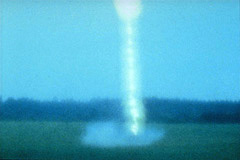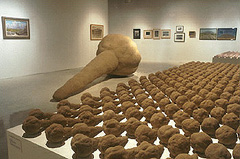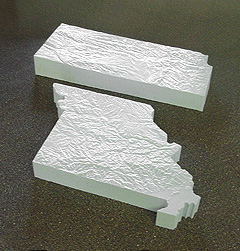|
Allan McCollum Whatever specific meaning the artist puts into a work, it will always retain its promise as a gift, its destiny as a keepsake. This is the artwork I am interested in making: an object filled with the absence of certain meaning, and yet rich with the quality of meaningfulness in and of itself. — Allan McCollum, 1989.
Biography: Allan McCollum was born in Los Angeles, California in 1944, and now lives and works in New York. He has spent over fifty years exploring how objects achieve public and personal meaning in a world constituted in mass production, focusing recently on collaborations with small community historical society museums in different parts of the world. In 2005, he designed The Shapes Project, a system to produce "a completely unique shape for every person on the planet, without repeating." His first solo exhibition was in 1971, and his first New York showing was in an exhibition at the Sidney Janis Gallery in 1972. He moved to New York in 1975, and in the late seventies he became especially well known for his series, Surrogate Paintings.
In discussing his recent 2004 exhibition at the Friedrich Petzel Gallery, Roberta Smith of the New York Times recently wrote:
"Part artist, part designer, part assembly-line savant, Allan McCollum continues his nearly 30-year project of demythologizing the aesthetic. His work takes the seemingly random details of everyday life, the bits of generic visual information that we have ceased to notice, and refocuses our attention by isolating, formalizing or magnifying them, but most of all by reproducing them in large quantities. In the process he banishes romantic notions of artistic touch, uniqueness or progress, while emphasizing factory production, art's commodity status, the importance of context and the systemic nature of just about everything."*
In 2003, art historian Rhea Anastas wrote of his recent work: "...McCollum has challenged the viewer's expectations of what is seen in art spaces by working with objects that share the qualities of rarity and preciousness with art works without actually being works of art (collectibles, souvenirs, minerals, fossils, natural copies). By collaborating with non-art museums (natural history museums, paleontological museums and small community museums), McCollum has also raised the stakes by considering these expectations within much broader historical and disciplinary frames than those provided by the art gallery."*
Artist and writer Richard Kalina has written: "While still dealing with the play between the elusive original and the assertive copy, McCollum has taken his speculation beyond modern cultural mechanics. He is doing something that is more difficult and, I think, more rewarding than reexamining the norms of contemporary society. He is dealing with history, memory and time."*
The late Craig Owens described his work in this way: "If McCollum represents the advent of a repetitive culture—both within the art gallery and without—a culture in which difference is "artificially recreated by means of the repetition of quasi-identical objects" (Attali), still, we cannot immediately assimilate him to that tradition of melancholic artists, from Duchamp to Sherrie Levine, who insist upon the diminished possibilities for creativity in an image-saturated world (or so it has been claimed). For the automatic, mechanical repetition that characterizes consumption is only one—the most superficial—type of repetition. Art invokes other, more profound types — those of memory and ultimately (following Freud's formulation of a compulsion to repeat) of death. The significance of McCollum's work resides in its superimposition of all three types, a superimposition which restores to repetition its critical — even revolutionary — power."*
McCollum has had over 100 solo exhibitions, including retrospectives at the Musée d'Art Moderne, Villeneuve d'Ascq, Lille, France (1998); the Sprengel Museum, Hannover, Germany (1995-96); the Serpentine Gallery, London (1990); the Rooseum Center for Contemporary Art, Malmo, Sweden (1990); IVAM Centre del Carme, Valencia, Spain (1990); Stedelijk Van Abbemuseum, Eindhoven, The Netherlands (1989), and Portikus, Frankfurt, Germany (1988). He has produced public art projects in the United States and Europe, and his works are held in over ninety art museum collections worldwide.
A number of interesting writers have published texts on Allan McCollum's work, including
Rhea Anastas,
Nicolas Bourriaud,
Martha Buskirk,
Lynne Cooke,
Hal Foster,
Andrea Fraser,
Suzi Gablik,
Claude Gintz,
Rosalind Krauss,
Thomas Lawson,
MaryJo Marks,
Johannes Meinhardt,
John Miller,
Helen Molesworth,
Lars Nittve,
Craig Owens,
Catherine Quéloz, and
Anne Rorimer.
McCollum has occasionally interviewed and written essays on fellow artists for books and catalogs, including
Matt Mullican,
Allen Ruppersberg,
Andrea Zittel, and
Harrell Fletcher.
Links Website with information on Allan McCollum |

